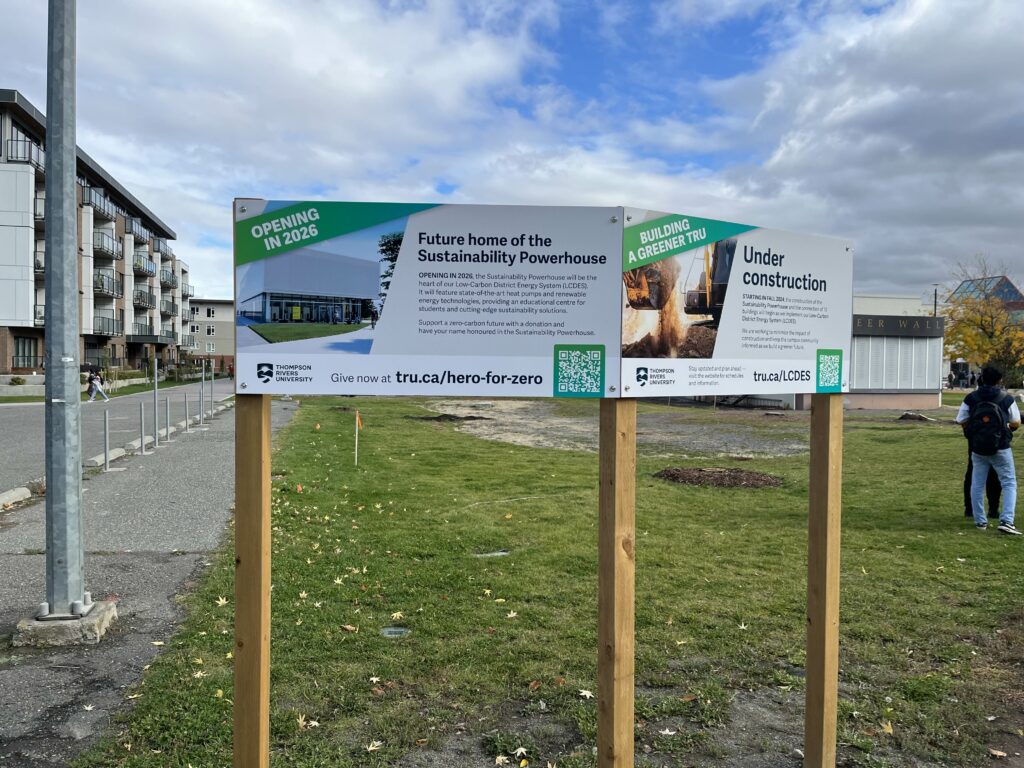Thompson Rivers University (TRU) is taking a significant step toward a greener future by constructing its Low-Carbon District Energy System (LCDES). The centerpiece of the LCDES project is the construction of the Sustainability Powerhouse.

As James Gordon, manager of sustainability programs at the sustainability office at TRU, says, “Half of the building will serve as an energy plant equipped with cutting-edge electrically powered air-source and water-source heat pumps alongside backup electric boilers. Then, if the electric boilers can’t keep up with the energy consumption, the natural gas boilers will make up the difference.” The Powerhouse will generate heat and distribute it through underground pipes to 13 existing campus buildings, including Arts and Education, BC Centre for Open Learning, Campus Activity Centre, Clock Tower, Culinary Arts Training Centre, Brown Family House of Learning, Indigenous Education Centre, International Building, Ken Lepin Science and Health Sciences Building, North Tower Residence, Old Library Administration and Research Annex (OLARA), Old Main and TRU Gymnasium. “Another cool thing is that the system can heat all the new condominium buildings and the Canada games pool in the tournament centre as part of The Reach development on campus.”

The other half of the Powerhouse will house the TRU Sustainability Office, a hub of environmental innovation and leadership. The office will use the Powerhouse as a “living lab,” showcasing state-of-the-art sustainable energy systems. Gordan mentioned, “The underground closed-loop distribution system will connect buildings across the campus, allowing TRU to phase out its aging boiler systems and transition to more efficient, renewable heating.”
The journey toward the LCDES began in 2021 when TRU engaged in public consultations to gather feedback on the project. By 2023, after refining its proposals based on public feedback, TRU submitted the project for review by the BC Utilities Commission (BCUC). The commission’s approval of the first phase of the system marked a significant milestone, providing the green light to move forward with the construction of the LCDES. This phase focuses on connecting key campus buildings to the new energy system, integrating innovative heating and cooling technologies that rely on renewable energy sources.
In addition to securing regulatory approval, TRU conducted another round of public consultations in 2023, this time focusing on the proposed second phase of the project. This phase envisions expanding the energy system to include more buildings, further enhancing the university’s ability to cut carbon emissions. The public consultations allowed TRU to present details on the expansion and gather feedback from the community, which continues to play a vital role in ensuring the project’s success.
When finished, the LCDES will not only meet TRU’s immediate energy needs but will also establish a scalable framework for future expansions. When asked about the impact of this project, Gordan said, “This project aims to drastically reduce the university’s greenhouse gas emissions by 95% by 2030. But of course, there is that 5% that is contributed to by people driving their cars to campus and other factors that TRU can’t exactly control. So, we are doing our best to ensure that the fossil fuel emissions we can control are as minimal as possible.” This approach underscores TRU’s long-term commitment to sustainability and ensures that the university will remain at the forefront of environmental innovation in British Columbia.
The Low Carbon and Energy-Efficient System (LCDES) is a step toward lowering carbon emissions and a comprehensive solution engineered to prioritize both resilience and sustainability. By integrating advanced air- and water-source heat pumps, the system ensures that renewable energy is the primary source for heating across the campus. These heat pumps efficiently extract thermal energy from the surrounding air or water, even at low temperatures, to meet the heating demands, significantly reducing reliance on fossil fuels.
In keeping with resilience planning, the system also includes electric and natural gas boilers that serve as a backup, ensuring uninterrupted heating during periods of peak demand or in extreme weather conditions when renewable sources might not suffice. This dual setup balances sustainability with reliability, making sure that while renewable sources are the focus, there is always a safeguard in place to maintain the campus’s heating needs.
Additionally, using heat pumps lowers greenhouse gas emissions by tapping into renewable energy sources, reducing the carbon footprint, and promoting long-term environmental sustainability. This design also supports the broader energy efficiency goals, contributing to reduced operational costs and aligning with the campus’s overall commitment to sustainability.
Strong partnerships with Creative Energy and BC Hydro have driven the development of the LCDES and have been instrumental in advancing this clean energy initiative. Together, these partnerships are helping TRU create a more sustainable campus while positioning the university as a leader in renewable energy solutions.
Sources:
Thompson Rivers University. (n.d.). Low carbon district energy system (LCDES). Thompson Rivers University. https://www.tru.ca/sustainability/lcdes.html
Thompson Rivers University. (2024, August 29). TRU breaks ground on landmark low carbon district energy system. Thompson Rivers University. https://inside.tru.ca/2024/08/29/tru-breaks-ground-on-landmark-low-carbon-district-energy-system/